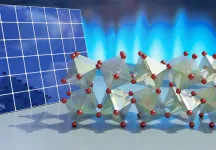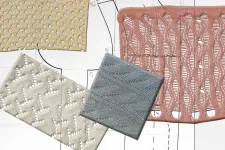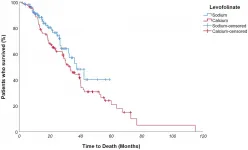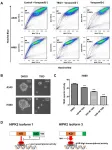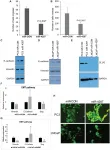Saarbrücken based bioinformaticians trace down molecular signals of Parkinson's disease
2021-03-15
(Press-News.org) In their study, which is now published in the journal Nature Aging, they show that the level of non-coding RNAs in the blood of a Parkinson's patient can be used to track the course of the disease. For their study, the team led by bioinformatics professor Andreas Keller and his doctoral student Fabian Kern created and analyzed the molecular profiles of more than 5,000 blood samples from over 1,600 Parkinson's patients. This resulted in around 320 billion data points, which the researchers analyzed for biomarkers of Parkinson's disease using artificial intelligence methods. "Our project is among the largest RNA biomarker studies in the world," says Andreas Keller, head of the research group for clinical bioinformatics at Saarland University and spokesperson for the Center for Bioinformatics at the Saarland Informatics Campus.
Of special interest was the level of a specific class of ribonucleic acids in the blood samples, so-called microRNAs. MicroRNAs are short, non-coding segments of RNA that play an important regulatory role in the translation of genetic information. "Because microRNAs are stable in the bloodstream, contain diverse information for diagnosis and prognosis, and their influence on an organism's genes has been well studied, we consider them promising candidates for robust biomarkers, also in the context of Parkinson's disease," says Fabian Kern, first author of the study and a doctoral student in Keller's research group. The group has already successfully identified microRNAs as diagnostic biomarkers for Alzheimer's disease and lung cancer in other large-scale studies.
With regard to Parkinson's disease, the bioinformaticians from Saarbrücken have now demonstrated that the disease progresses in particularly strong molecular waves during the third decade of life and from around the age of 70. "The indication for this effect is the increased concentration of deregulated microRNAs that we found in blood samples of the corresponding study cohorts," explains Andreas Keller. The researchers obtained the blood samples from one of the largest Parkinson's studies in the world, the 'Parkinson's Progression Markers Initiative (PPMI)' from the USA. Since the PPMI dataset is a longitudinal study, they were able to investigate in particular whether the concentration of microRNAs varies over the time axis and thus draw conclusions about the progression of the disease. The researchers replicated their results using independently collected samples from a second cohort of more than 1,000 patients provided to them by the Centre for Systems Biomedicine in Luxembourg.
In the current study, the bioinformaticians at Saarland University worked with whole blood analyses and examined the total concentration of microRNAs in all blood cells. In doing so, they were able to show that the information content of certain cell types varies depending on the subject's age and stage of illness. "In the future, we want to analyze the blood down to the single-cell level, which will allow us to make much more precise statements," says Keller with regard to future research projects.
A total of eleven institutions were involved in the current study, among them Stanford University, where Andreas Keller was a visiting professor in 2019 and 2020, the Translational Genomics Research Institute (TGen) in Phoenix, the University of Southern California in Los Angeles and the University of California in San Diego. "The fact that our expertise in the field of microRNAs and bioinformatics is recognized on an international level and that we play a leading role in a predominantly American study shows the quality of research at the Saarland Informatics Campus," says Andreas Keller.
INFORMATION:
Background Saarland Informatics Campus:?
800 scientists and about 2100 students from more than 80 nations make the Saarland Informatics Campus (SIC) one of the leading locations for computer science in Germany and Europe. Five world-renowned research institutes, namely the German Research Center for Artificial Intelligence (DFKI), the Max Planck Institute for Computer Science, the Max Planck Institute for Software Systems, the Center for Bioinformatics and the Cluster for "Multimodal Computing and Interaction" as well as Saarland University with three departments and 21 study programmes cover the entire spectrum of computer science.
Original Publication:
The publication entitled 'Deep sequencing of sncRNAs reveals hallmarks and regulatory modules of the transcriptome during Parkinson's disease progression', will be published as a cover story in the March issue of the journal 'Nature Aging' and will be accompanied by a commentary from an independent expert.
https://dx.doi.org/10.1038/s43587-021-00042-6
[Attachments] See images for this press release:

ELSE PRESS RELEASES FROM THIS DATE:
2021-03-15
DURHAM, N.C. -- Researchers at Duke University have revealed long-hidden molecular dynamics that provide desirable properties for solar energy and heat energy applications to an exciting class of materials called halide perovskites.
A key contributor to how these materials create and transport electricity literally hinges on the way their atomic lattice twists and turns in a hinge-like fashion. The results will help materials scientists in their quest to tailor the chemical recipes of these materials for a wide range of applications in an environmentally friendly way.
The results appear online March 15 in the journal Nature Materials.
"There is a broad ...
2021-03-15
An epigenetic modification that occurs in a major cell type in the brain's reward circuitry controls how stress early in life increases susceptibility to additional stress in adulthood, researchers at the Icahn School of Medicine at Mount Sinai have learned. In a study in Nature Neuroscience, the team also reported that a small-molecule inhibitor of the enzyme responsible for this modification, currently being developed as an anti-cancer drug, was able to reverse increased vulnerability to lifelong stress in animal models.
"It has long been known that stress exposures throughout life control lifelong susceptibility to subsequent stress. Here ...
2021-03-15
Researchers have found that out of the more than 300 COVID-19 machine learning models described in scientific papers in 2020, none of them is suitable for detecting or diagnosing COVID-19 from standard medical imaging, due to biases, methodological flaws, lack of reproducibility, and 'Frankenstein datasets.'
The team of researchers, led by the University of Cambridge, carried out a systematic review of scientific manuscripts - published between 1 January and 3 October 2020 - describing machine learning models that claimed to be able to diagnose or prognosticate ...
2021-03-15
In considering materials that could become the fabrics of the future, scientists have largely dismissed one widely available option: polyethylene.
The stuff of plastic wrap and grocery bags, polyethylene is thin and lightweight, and could keep you cooler than most textiles because it lets heat through rather than trapping it in. But polyethylene would also lock in water and sweat, as it's unable to draw away and evaporate moisture. This antiwicking property has been a major deterrent to polyethylene's adoption as a wearable textile.
Now, MIT engineers have spun polyethylene into fibers ...
2021-03-15
The loss of glaciers worldwide enhances the breakdown of complex carbon molecules in rivers, potentially contributing further to climate change.
An international research team led by the University of Leeds has for the first time linked glacier-fed mountain rivers with higher rates of plant material decomposition, a major process in the global carbon cycle.
As mountain glaciers melt, water is channelled into rivers downstream. But with global warming accelerating the loss of glaciers, rivers have warmer water temperatures and are less prone to variable water flow and sediment movement. These conditions are then much more favourable for fungi to establish and ...
2021-03-15
Ageing is a common factor in many diseases. So, what if it were possible to treat them by acting on the causes of ageing or, more specifically, by acting on the shortening of telomeres, the structures that protect chromosomes? This strategy is being pursued by the Telomeres and Telomerase Group of the Spanish National Cancer Research Centre (CNIO), which has already succeeded to cure pulmonary fibrosis and infarctions in mice by lengthening telomeres. Now they take a first step towards doing the same with renal fibrosis by demonstrating that short telomeres are at the origin of this disease, ...
2021-03-15
Oncotarget published "Folinic acid in colorectal cancer: esquire or fellow knight? Real-world results from a mono institutional, retrospective study" which reported that the stock of therapeutic weapons available in metastatic colorectal cancer has been progressively grown over the years, with improving both survival and patients' clinical outcome: notwithstanding advances in the knowledge of mCRC biology, as well as advances in treatment, fluoropyrimidine antimetabolite drugs have been for 30 years the mainstay of chemotherapy protocols for this malignancy.
5-Fluorouracil seems to act differently depending on administration method: elastomer-mediated continuous infusion better inhibits Thymidylate ...
2021-03-15
Oncotarget published "A novel isoform of Homeodomain-interacting protein kinase-2 promotes YAP/TEAD transcriptional activity in NSCLC cells" which reported that In this study, the authors show that a new HIPK2 isoform increases TEAD reporter activity in NSCLC cells.
They detected and cloned a novel HIPK2 isoform 3 and found that its forced overexpression promotes TEAD reporter activity in NSCLC cells.
Expressing HIPK2 isoform 3_K228A kinase-dead plasmid failed to increase TEAD reporter activity in NSCLC cells.
Next, they showed that two siRNAs targeting HIPK2 decreased HIPK2 isoform 3 and YAP protein levels in NSCLC cells.
In summary, this Oncotarget study indicates that HIPK2 isoform 3, the main HIPK2 isoform ...
2021-03-15
The cover for issue 51 of Oncotarget features Figure 5, "miR-4287 overexpression regulates EMT in prostate cancer cell lines," published in "MicroRNA-4287 is a novel tumor suppressor microRNA controlling epithelial-to mesenchymal transition in prostate cancer" by Bhagirath, et al. which reported that the authors analyzed the role of miR-4287 in PCa using clinical tissues and cell lines.
Receiver operating curve analysis showed that miR-4287 distinguishes prostate cancer from normal with a specificity of 88.24% and with an Area under the curve of 0.66. Further, these authors found that miR-4287 ...
2021-03-15
NEW YORK, NY (March 15, 2021)--A cytokine "hurricane" centered in the lungs drives respiratory symptoms in patients with severe COVID-19, a new study by immunologists at Columbia University Vagelos College of Physicians and Surgeons suggests.
Two cytokines, CCL2 and CCL3, appear critical in luring immune cells, called monocytes, from the bloodstream into the lungs, where the cells launch an overaggressive attempt to clear the virus.
Targeting these specific cytokines with inhibitors may calm the immune reaction and prevent lung tissue damage. Currently, one drug that blocks immune responses to CCL2 is being studied in clinical trials of patients with severe COVID-19.
Survivors of severe COVID-19, the study also found, had a greater abundance of antiviral T cells in their lungs ...
LAST 30 PRESS RELEASES:
[Press-News.org] Saarbrücken based bioinformaticians trace down molecular signals of Parkinson's disease

